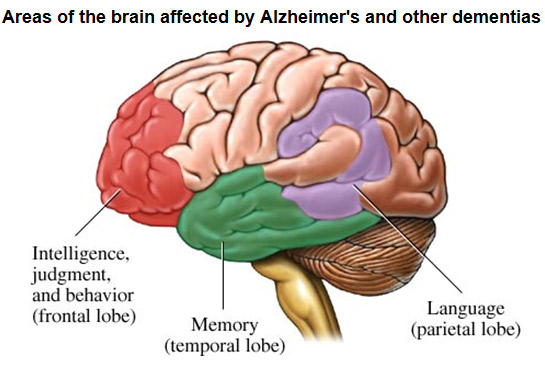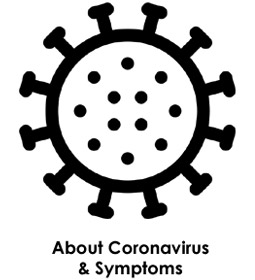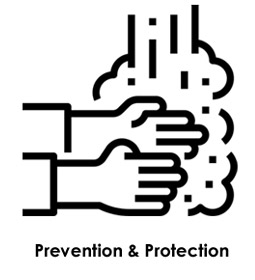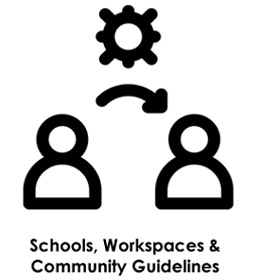Alzheimer’s and Other Forms of Dementia
Dementia is the loss of mental functions — such as thinking, memory, and reasoning — that is severe enough to interfere with a person’s daily functioning. Dementia is not a disease itself, but rather a group of symptoms that are caused by various diseases or conditions. Symptoms can also include changes in personality, mood, and behavior. In some cases, the dementia can be treated and cured because the cause is treatable. Examples of this include dementia caused by drugs or alcohol, or hormone or vitamin imbalances. In some cases, although the person may appear to have dementia, a severe depression can be causing the symptoms. This is known as pseudo-dementia (false dementia) and is highly treatable. In most cases, however, dementia cannot be cured.
Dementia develops when the parts of the brain that are involved with learning, memory, decision-making, and language are affected by one or more of a variety of infections or diseases. The most common cause of dementia is Alzheimer’s disease, but there are as many as 50 other known causes. Most of these causes are very rare.
 |
Because some causes of dementia can be cured or partially treated, it is very important that your doctor is thorough when making the diagnosis, so as not to miss potentially treatable conditions. The frequency of “treatable” causes of dementia is believed to be about 20%.
What Causes Dementia?
|
- Nutritional deficiencies, like vitamin B12 and folate deficiency
- Infections that affect the central nervous system, such as AIDS dementia complex and Creutzfeldt-Jakob disease
- Certain types of hydrocephalus, an accumulation of fluid in the brain that can result from developmental abnormalities, infections, injury, or brain tumors
- Head injury — either a single severe head injury or longer term smaller injuries, like in boxers
Illness other than in the brain — kidney, liver, and lung diseases can all lead to dementia
Alzheimer’s disease causes 50-70% of all demetias. But researchers have found that two nervous diseases, which were originally incorrectly diagnosed as Alzheimer’s, are emerging as major causes of dementia: Lewy body disease and Pick’s disease.
How Common Is Dementia?
Although dementia has always been somewhat common, it has become even more common among the elderly in recent history. It is not clear if this increased frequency of dementia reflects a greater awareness of the symptoms, or if people simply are living longer and thus are more likely to develop dementia in their older age.
Dementia caused by nervous system disease, especially Alzheimer’s disease, is increasing in frequency more than most other types of dementia. Some researchers suspect that as many as half of all people over 80 years old develop Alzheimer’s disease. Also, the increased incidence of AIDS dementia complex, which results from HIV infection, helps account for the increased dementia in recent history, although with the invention of newer and better drugs to treat HIV, the occurrence of AIDS-associated dementia is declining.
Who Gets Dementia?
Dementia is considered a late-life disease because it tends to develop mostly in elderly people. About 5-8% of all people over the age of 65 have some form of dementia, and this number doubles every five years above that age. It is estimated that as many as half of people in their 80s suffer from dementia.
Which Dementias Are Treatable?
- Dementia due to long-term drug abuse
- Tumors that can be removed
- Subdural hematoma, accumulation of blood beneath the outer covering of the brain that results from a broken blood vessel, usually as a result of a head injury
- Normal pressure hydrocephalus
- Metabolic disorders, such as a vitamin B12 deficiency
- Hypothyroidism, a condition that results from an under-active thyroid
- Hypoglycemia, a condition that results from low blood sugar
What Are Some of the Non-treatable Causes of Dementia?
- Alzheimer’s disease
- Multi-infarct dementia (Dementia due to multiple small strokes)
- Dementias associated with Parkinson’s disease and similar disorders
- AIDS dementia complex
- Creutzfeldt-Jakob disease (CJD), a quickly progressing and fatal disease that consists of dementia and muscle twitching and spasm
Symptoms
Symptoms of dementia vary depending on the cause and the location of damage in the brain.
Memory loss is the earliest and most noticeable symptom in Alzheimer’s disease. (For more information, see the topic Alzheimer’s Disease.) Memory loss also may develop in other types of dementia.
Other key symptoms of dementia include difficulty:
- Recalling recent events.
- Recognizing previously familiar people and places.
- Finding the right words to express thoughts or name objects.
- Performing calculations.
- Planning and carrying out tasks, such as balancing a checkbook, following a recipe, or writing a letter.
- Exercising judgment, such as knowing what to do in an emergency.
- Controlling moods or behaviors; depression is common, and agitation or aggression may occur.
- Maintaining personal care such as grooming.
Some disorders that cause dementia have hallmark symptoms.
- People who have dementia with Lewy bodies often have highly detailed visual hallucinations or firmly held false beliefs (delusions). They may fall frequently.
- The first symptoms of frontotemporal dementia may be personality changes or unusual behavior. A previously happy person may suddenly become angry and sullen, or a person may display a loss of inhibition, such as blurting out inappropriate sexual comments.
Symptoms of dementia that come on suddenly suggest multi-infarct dementia or possibly delirium—short-term confusion caused by a new or worsening illness.
It is important to know that memory loss can be caused by conditions other than dementia. Another condition may be likely if memory loss occurs without any other signs of dementia. Occasional trouble with memory (such as briefly forgetting someone’s name) can be a normal part of aging, although all memory loss should be evaluated by a health professional.
Depression, delirium, and seizures are among the conditions that can cause memory loss. Depression can cause other symptoms similar to those of dementia, such as confusion and disorientation.

Alzheimer’s Disease Basics
Alzheimer’s disease is a condition in which nerve cells in the brain die, making it difficult for the brain’s signals to be transmitted properly. A person with Alzheimer’s disease has problems with memory, judgment, and thinking, which makes it hard for the person to work or take part in day-to-day life. The death of the nerve cells occurs gradually over a period of years.
Once thought to be rare, Alzheimer’s disease is the leading cause of dementia.
What Are the Symptoms of Alzheimer’s Disease?
Most patients’ symptoms progress slowly over a number of years. Symptoms may not be noticed early on. Sometimes, it is only when family members look back that they realize when the changes started to occur.
Common symptoms of Alzheimer’s disease include:
- Impaired memory and thinking. The person has difficulty remembering things or learning new information. In the later stages of the disease, long-term memory loss occurs, which means that the person can’t remember personal information, such as his or her place of birth or occupation, or names of close family members.
- Disorientation and confusion. People with Alzheimer’s disease may get lost when out on their own and may not be able to remember where they are or how they got there. They may not recognize previously familiar places and situations. They also may not recognize familiar faces or know what time of the day it is, or even what year it is.
- Misplacing things. The person forgets where he or she put things used every day, such as glasses, a hearing aid, keys, etc. The person may also put things in strange places, such as leaving their glasses in the refrigerator.
- Abstract thinking. People with Alzheimer’s disease may find certain tasks — such as balancing a checkbook — more difficult than usual. For example, they might forget what the numbers mean and what needs to be done with them.
- Trouble performing familiar tasks. The person begins to have difficulty performing daily tasks, such as eating, dressing, and grooming. Planning for normal day-to-day tasks is also impaired.
- Changes in personality and behavior. The person becomes unusually angry, irritable, restless, or quiet. At times, people with Alzheimer’s disease can become confused, paranoid, or fearful.
- Poor or decreased judgment. People with Alzheimer’s disease may leave the house on a cold day without a coat or shoes, or could go to the store wearing their pajamas.
- Inability to follow directions. The person has difficulty understanding simple commands or directions. The person may get lost easily and begin to wander.
- Problems with language and communication. The person can’t recall words, name objects (even ones that are very familiar to them — like a pen), or understand the meaning of common words.
- Impaired visual and spatial skills. The person loses spatial abilities (the ability to judge shapes and sizes, and the relationship of objects in space) and can’t arrange items in a certain order or recognize shapes.
- Loss of motivation or initiative. The person may become very passive and require prompting to become involved and interact with others.
- Loss of normal sleep patterns. The person may sleep during the day and be wide-awake at night.
How Is It Diagnosed?
It is important to visit a doctor if you or a loved one experiences any of these symptoms so you can receive the proper evaluation and diagnosis. There are other conditions — such as depression, a head injury, certain chemical imbalances, or the effects of some medications –that can produce symptoms that are similar to Alzheimer’s disease. Many of these conditions are treatable.
Your doctor can only determine if the symptoms are probably due to Alzheimer’s disease after a thorough medical, psychiatric, and neurological evaluation. He will evaluate other possible causes of dementia to rule out all other factors before settling on Alzheimer’s disease as a diagnosis.
Currently, no definitive diagnostic test for Alzheimer’s exists. A definite diagnosis of Alzheimer’s disease is possible only after death, when a pathologist can more closely examine a patient’s brain for the telltale changes associated with Alzheimer’s disease.
What’s the Prognosis?
The course of Alzheimer’s disease varies widely from person to person. The duration of the illness could be short (2-3 years) or long (up to 20 years). Usually the parts of the brain that control memory and thinking are affected first, but over time, cells die in other areas of the brain.
Eventually, a person with Alzheimer’s will need complete care. If the person has no other serious illnesses, the loss of brain function itself will eventually cause death.
Can Alzheimer’s Disease be Prevented?
Because the exact cause of Alzheimer’s disease is not known, there is currently nothing that can be done to prevent it. It is important to remember, however, that there are causes of dementia other than Alzheimer’s disease that may be preventable such as eating properly, exercising, quitting smoking, and limiting how much alcohol you drink. Your doctor can advise you about other healthy lifestyle habits you can adopt that may help prevent dementia.
Alzheimer’s Types
Doctors have categorized Alzheimer’s into the following types:
- Early onset Alzheimer’s. This is a rare form of Alzheimer’s disease in which people are diagnosed with the disease before age 65. Less than 10% of all Alzheimer’s disease patients have this type. Because they experience premature aging, people with Down syndrome are particularly at risk for a form of early onset Alzheimer’s disease. Adults with Down syndrome are often in their mid- to late 40s or early 50s when symptoms first appear.
Younger people who develop Alzheimer’s disease have more of the brain abnormalities that are associated with Alzheimer’s disease. Early onset Alzheimer’s appears to be linked with a genetic defect on chromosome 14, to which late-onset Alzheimer’s is not linked. A condition called myoclonus — muscle twitching and spasm — also is more commonly seen in early onset Alzheimer’s than in late-onset Alzheimer’s.
- Late-onset Alzheimer’s. This is the most common form of Alzheimer’s disease, usually occurring after age 65. Late-onset Alzheimer’s disease strikes almost half of all people over the age of 85 and may or may not be hereditary. Late-onset dementia is also called sporadic Alzheimer’s disease.
- Familial Alzheimer’s disease (FAD). This is a form of Alzheimer’s disease that is known to be entirely inherited. In affected families, members of at least two generations have had Alzheimer’s disease. FAD is extremely rare, accounting for less than 1% of all cases of Alzheimer’s disease. It has a much earlier onset (often in the 40s) and can be clearly seen to run in families.









